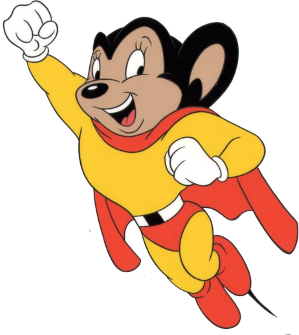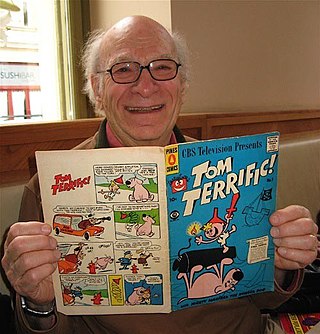Related Research Articles

Mighty Mouse is an American animated character created by the Terrytoons studio for 20th Century Fox. He is an anthropomorphic superhero mouse, originally called Super Mouse, and made his debut in the 1942 short The Mouse of Tomorrow. The name was changed to Mighty Mouse in his eighth film, 1944's The Wreck of the Hesperus, and the character went on to star in 80 theatrical shorts, concluding in 1961 with Cat Alarm.

The golden age of American animation was a period that began with the popularization of sound synchronized cartoons in 1928 and gradually ended in the 1960s when theatrical animated shorts started to lose popularity to the newer medium of television. Animated media from after the golden age, especially on television, were produced on cheaper budgets and with more limited techniques between the late 1950s and 1980s.

Terrytoons was an American animation studio headquartered in New Rochelle, New York that produced animated cartoons for theatrical release from 1929 to 1973. It was founded by Paul Terry, Frank Moser, and Joseph Coffman, and operated out of the "K" Building in downtown New Rochelle. The studio created many cartoon characters including Fanny Zilch, Mighty Mouse, Heckle and Jeckle, Gandy Goose, Sourpuss, Dinky Duck, Little Roquefort, the Terry Bears, Dimwit, and Luno; Terry's pre-existing character Farmer Al Falfa was also featured often in the series.
John Frederick Hannah was an American animator, writer and director of animated shorts. He worked for Disney and Walter Lantz.

Famous Studios was the first animation division of the film studio Paramount Pictures from 1942 to 1967. Famous was established as a successor company to Fleischer Studios, after Paramount seized control of the aforementioned studio amid the departure of its founders, Max and Dave Fleischer, in 1942. The studio's productions included three series started by the Fleischers—Popeye the Sailor, Superman, and Screen Songs—as well as Little Audrey, Little Lulu, Casper the Friendly Ghost, Honey Halfwitch, Herman and Katnip, Baby Huey, and the Noveltoons and Modern Madcaps series.
Vladimir Peter "Bill" Tytla was a Ukrainian-American animator known for his work in Walt Disney Animation Studios, Paramount's Famous Studios, and Terrytoons. In his Disney career, Tytla is particularly noted for the animation in Snow White and the Seven Dwarfs, Pinocchio, Fantasia and Dumbo. He was inducted as a Disney Legend in 1998.
The Looney Tunes Golden Collection is a series of six four-disc DVD sets from Warner Home Video, each containing about 60 Looney Tunes and Merrie Melodies animated shorts originally released from the 1930s to 1960s. The initial run of the series was in folding cardboard packaging issued gradually from October 28, 2003, to October 21, 2008. A boxed set combining all six volumes was released in 2011, and each volume was reissued separately in standard Amaray-style cases in 2020.
Warner Bros. Cartoons, Inc. was an American animation studio, serving as the in-house animation division of Warner Bros. during the Golden Age of American animation. One of the most successful animation studios in American media history, it was primarily responsible for the Looney Tunes and Merrie Melodies series of animated short films. The characters featured in these cartoons, including Bugs Bunny, Daffy Duck, and Porky Pig, are among the most famous and recognizable characters in the world. Many of the creative staff members at the studio, including directors and animators such as Chuck Jones, Friz Freleng, Robert McKimson, Tex Avery, Robert Clampett, Arthur Davis, and Frank Tashlin, are considered major figures in the art and history of traditional animation.

Eugene Merril Deitch was an American illustrator, animator, comics artist, and film director who was based in Prague from the 1960s until his death in 2020. Deitch was known for creating animated cartoons such as Munro, Tom Terrific, and Nudnik, as well as his work on the Popeye and Tom and Jerry series.

Deputy Dawg is a Terrytoons cartoon character, featured on the animated television series of the same name that aired from 1960 to 1964.

Mighty Mouse: The New Adventures is an American animated television series. It is a revival of the Mighty Mouse cartoon character. Produced by Bakshi-Hyde Ventures and Terrytoons, the show aired on CBS on Saturday mornings from fall 1987 through the 1988–89 season. It was briefly rerun on Saturday mornings on Fox Kids in November and December 1992.

Heckle and Jeckle are postwar animated cartoon characters created by Paul Terry, originally produced at his own Terrytoons animation studio and released through 20th Century Fox. The characters are a pair of identical anthropomorphic yellow-billed magpies who usually cause problems to others and for themselves with their bizarre antics. Heckle speaks in a tough New York style manner, while Jeckle has a more polite British accent. They were voiced at different times by Dayton Allen (1946–66), Sid Raymond (1947), Roy Halee, and Frank Welker (1979).
Rokuro "Bob" Kuwahara was a Japanese-born American animator best known for his work with Walt Disney and Terrytoons between the 1930s and 1960s.
The Astronut Show is an animated TV series, produced by the Terrytoons animation studio. It first aired on August 23, 1965. In the late 1960s, each episode included Astronut, Hashimoto-san, and Luno the White Stallion. In the early 1970s, the episodes were reprogrammed; these episodes included Astronut, Sad Cat and James Hound.
Luno the White Stallion is a Terrytoons cartoon character. The series of cartoons centered on a little boy, Tim, who had a toy horse of marble white, Luno. Luno would come alive and whisk him off on adventures in far off lands when Tim said the words, "Oh winged horse of marble white, take me on a magic flight". The series was produced by William Weiss, and directed by Connie Rasinski and Arthur Bartsch.

Sylvester J. Pussycat Jr., simply known as Sylvester Jr., is an animated cartoon character in the Warner Bros. Looney Tunes and Merrie Melodies series. He was created by Robert McKimson.
Lionel Wilson was an American voice actor, reader of audiobooks, stage actor, and author of children's books. He was known for his roles from Tom Terrific through to his last role, voicing Eustace Bagge on the Cartoon Network's Courage the Cowardly Dog.
Hector Heathcote is a Terrytoons animated cartoon character. Created by Eli Bauer and Ralph Bakshi, he first appeared on July 18, 1959, in The Minute and a Half Man. He was voiced by John Myhers. Terrytoons created the character for television, but the cartoons also received theatrical distribution.
References
- 1 2 3 Lenburg, Jeff (1999). The Encyclopedia of Animated Cartoons. Checkmark Books. p. 89. ISBN 0-8160-3831-7 . Retrieved 6 June 2020.
- ↑ Hashimoto-san at Don Markstein's Toonopedia. Archived from the original on March 8, 2015.